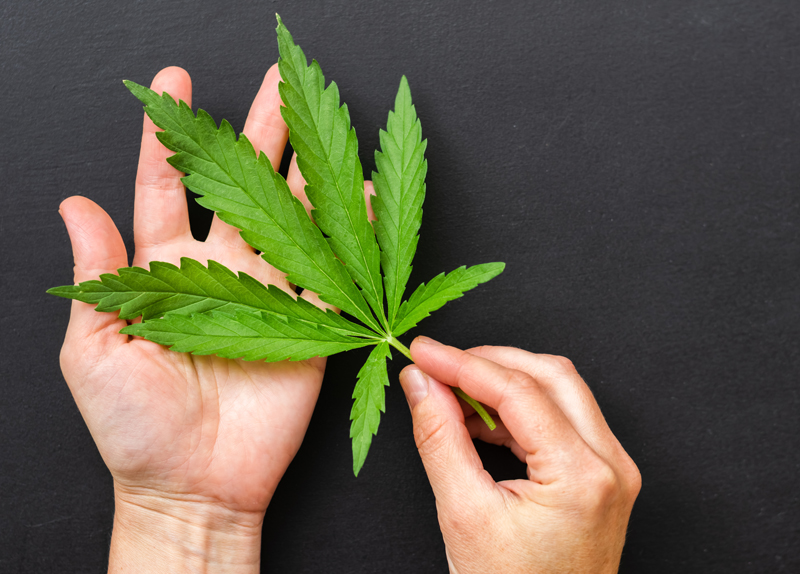Emerging evidence suggests that all plant compounds in cannabis work together synergistically—this is known as the entourage effect and can be thought of as: The whole of all compounds present in cannabis are more together than the sum of its parts. In other words, a special whole-plant synergy occurs when cannabinoids and terpenes are consumed together, as opposed to by themselves.
For example, terpenes appear to play a part in influencing the effects of THC and CBD in the body. In a 2018 review of people with epilepsy, those who took full-spectrum CBD extract—including cannabinoids and terpenes—experienced improved symptoms and fewer side effects than those who took CBD to isolate, only containing cannabinoids. Full-spectrum cannabis extract is whole-plant medicine, containing cannabinoids, terpenes, and other compounds that are present in the plant.
The researchers also found that full-spectrum CBD extract was four times more potent than the CBD isolate, meaning patients could take a significantly lower dose and attributed this to the therapeutic synergy of cannabinoids and other compounds, such as terpenes.
More recent research has found that terpenes boost cannabinoid activity, but high concentrations of terpenes were needed to see this enhancement.
It’s vital to acknowledge that much is still unknown about terpenes and their interactions with other terpenes, cannabinoids, and flavonoids present in cannabis. In addition, the majority of the research we do have is based on animal or test-tube models.
Nonetheless, growing clinical interest in these aromatic compounds is yielding some fascinating findings. It’s likely that the coming years will see a more sophisticated understanding of terpenes develop, and how they behave both individually and synergistically.
The top three terpenes found in cannabis
Terpinolene is found in lilacs, nutmeg, cumin, and apples.
As mentioned earlier, there’s a staggering range of terpenes present in cannabis—more than 150 different types, to be exact. While many of these occur in concentrations too low to detect, some have a more robust presence.
Here’s the lowdown on three terpenes that are the most predominant in cannabis.
Myrcene
Most cannabis cultivars are dominant in either myrcene or caryophyllene. Myrcene, a terpene that’s also predominant in hops and lemongrass, has been described as delivering scent notes that are herbaceous, spicy, earthy, and musky. Myrcene gives cannabis a mildly sweet flavor profile—it’s also found in mangoes.
In addition to contributing to the signature scent of cannabis, myrcene can also deliver anti-inflammatory effects. A 2015 study in cultured cells indicates that myrcene may effectively reduce inflammation associated with osteoarthritis.
The terpene also appeared to help prevent the breakdown of cartilage cells, slow down the progression of osteoarthritis, and decrease the production of certain inflammatory cells produced by the body. Myrcene could potentially be harnessed to help alleviate anti-inflammatory diseases and their symptoms in the future.
Caryophyllene
Caryophyllene, also known as beta-caryophyllene or β-caryophyllene, lends a spicy, peppery bite to some cannabis strains. Caryophyllene is also found in other plants such as cloves, rosemary, oregano, and black pepper. If you catch any of these scents when you smell a certain cannabis cultivar, it’s likely because caryophyllene is present.
Caryophyllene is the only known terpene found in cannabis that can bind to the CB2 receptor in the endocannabinoid system, which is found in the body’s immune system. Thanks to this unique action, caryophyllene is sometimes also classed as an atypical cannabinoid.
Research into the therapeutic actions of caryophyllene shows that it has the potential in easing symptoms in diverse conditions such as colitis, diabetes, cerebral ischemia, anxiety and depression, liver fibrosis, and Alzheimer-like diseases.
Future research suggests that caryophyllene’s activity at the CB2 receptor could be harnessed to help treat conditions that are accompanied by inflammatory symptoms.
Limonene
Clean, fresh, uplifting citrus-y scents—limonene’s name is a giveaway for the aromas associated with this terpene. Limonene is found in the rinds of citrus fruits and ginger, and the terpene is also predominant in many cannabis cultivars that have a fruity, fresh bouquet, like Papaya Punch or Black Cherry Soda.
Limonene appears to alter the way certain immune cells in the body behave, which may protect the body from a range of disorders. In one study, limonene helped to increase the production of antibody-producing cells in the spleen and bone marrow, which are used by the immune system to identify and neutralize pathogenic bacteria and viruses.
Researchers have also recently floated the idea that the unique therapeutic profile of limonene could be useful in treatments for Covid-19.

